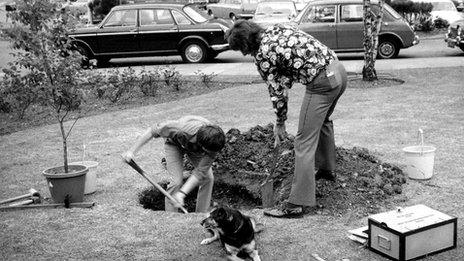Bright poor 'held back for decades'
- Published

Blue Peter generation: Social mobility had not reached education in the 1960s
The level of qualifications achieved by adults now in their 40s, 50s and 60s was influenced by social background as much as their own intelligence, according to a long-term study from the University of Oxford.
It found that children of the same ability went on to achieve very different levels of exam results.
Academics tracked 5,000 people in England, Scotland and Northern Ireland.
It comes as a report on social mobility is about be published.
The study, from Oxford University's Department of Social Policy and Intervention, examined the academic achievements of cohorts of people born between the late 1940s and 1970.
Their academic results as young adults were compared with cognitive ability tests taken when they were aged between 10 and 13.
Wasted potential
It showed that children from wealthier and better educated families had been much more successful in exam results than poorer children of a similar intelligence level.

Blue Peter time capsule, 1971: The brightest poor children were only half as likely to get A-levels as wealthier classmates
It meant that many poor, bright young people leaving school in the 1960s, 1970s and 1980s failed to reach their full potential.
Among the youngest of this survey, leaving school in the mid-1980s, fewer than one in five went to university. Among the oldest group, who would have left school in the early 1970s, only about one in 20 reached degree level.
Last week figures from the OECD think tank indicated the 55-65 age group in England had stronger literacy and numeracy skills than 16-24-year-olds, even though the younger group had much better qualifications.
The OECD has warned about the diminishing job prospects for those without skills.
And this study shows the long roots of the academic gap between rich and poor and the lack of social mobility in education.
What surprised the Oxford University researchers was that a parallel study in Sweden, across the same decades, also showed a strong link between economic background and academic achievement.
The lead author of the study, Erzsebet Bukodi, said there were expectations that Sweden would have had more equal outcomes, but the results showed that poorer children were also disadvantaged there.
Not-so-swinging 60s
Co-author, Prof John Goldthorpe, said the results showed that Sweden was not "significantly ahead" in terms of a meritocratic system and he said it raised questions about whether educational policies could be used to promote social mobility.
Dr Bukodi also highlighted how the 1950s, 1960s and 1970s were decades of great social change, with a perception of increased social mobility, but the studies in England, Scotland and Northern Ireland and Sweden showed a sustained picture of a social gap in exam results.
Across three decades there had been no diminishing of this link between social background and achievement, said Dr Bukodi.
Despite the lack of a level playing field, it still remained possible for bright children from poorer backgrounds to out-perform those who were from wealthier backgrounds, but with less intelligence.
But it was an uphill struggle.
The study suggests that among the cleverest children born in England, Scotland and Northern Ireland in 1970, in the top fifth of the ability range, 80% of the richest children achieved two A-levels or their equivalent, compared with only 40% for the poorest.
It meant that for poor children with high levels of intelligence, a majority left school in the 1980s without two A-levels.
"We see that in both the British and Swedish educational systems, even the very brightest children are hampered if they come from a disadvantaged background," said Dr Bukodi.
"It is possible of course that clever individuals choose other ways of getting on in the world than through education, but the fact remains that many children in British and Swedish schools do not appear to fulfil their academic potential."